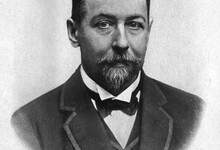- Images (1)
- Links (0)
- Agenda (0)

|

|
Born in Reims, France, in 1859, Eugène-Louis Doyen became renowned for his technical innovations in abdominal and vaginal surgery. Several surgical instruments bear his name (Doyen's forceps, Doyen's raspatory, etc.). He also authored several richly illustrated surgical manuals. His fame was such that he was called to the bedside of the dying French socialist leader Jean Jaurès.
However, Doyen's enduring legacy is primarily as the father of surgical films. He intended his films for a specialized audience of students and colleagues, stating, "Students will no longer uselessly clutter operating rooms, where they often attend merely as curious onlookers... they will have to undergo preparatory training before being admitted to the surgeon's side."
Evidently, his modesty was... modest. He immediately leveraged the impact of wider distribution for international communication: "...You will make a thousand people understand in less than a minute what any lecture could only demonstrate to a small number of students." As sound recording did not yet exist, a brochure accompanied the presentations.
Cinema reportedly allowed him to refine his surgical techniques, seek better posture, and evolve his operating instruments, driven by an inventive spirit that led him to create a whole series of instruments linked to his name and still in common practice. On the other hand, he was criticized for wide shots that seemed to highlight the surgeon more than the operation itself.
On July 29, 1898, in Edinburgh, Doyen presented three films depicting an operating table of his own design, an abdominal hysterectomy, and a craniotomy. The first official screening in France took place on October 21, against the advice of the Academy of Medicine and the Paris Congress of Surgery, marking the first official public screening of surgical films.
Despite his pioneering work, Doyen's methods and self-promotion sometimes generated irritation and jealousy. His former cameraman controversially sold his films without his knowledge. Special screenings, sometimes held in fairground booths, targeted not a specialized audience but spectators eager for sensations. These projections, organized across Europe, brought discredit upon the surgeon. This was particularly true for the famous operation where he separated two conjoined twin sisters.
Furthermore, Eugène Doyen conducted questionable experiments, such as grafting cancerous tissue from an operated breast cancer into the other breast.
He passed away in 1916. Tragically, his invaluable series of films disappeared, and his work on color cinematography was lost with the outbreak of World War I in 1914. Almost everything was lost between the bankruptcy of the Éclipse company and Gaumont, which suffered a fire during the war.

|
SÉPARATION DES SŒURS SIAMOISES
1902 / b&w / silent / single screen / 5' 00 / 37 € distribution: Digital file on server |